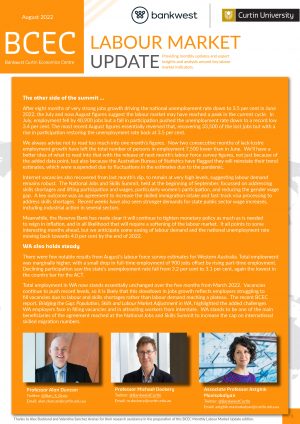BCEC Monthly Labour Market Update – August 2022
The other side of the summit …
After eight months of very strong jobs growth driving the national unemployment rate down to 3.5 per cent in June 2022, the July and now August figures suggest the labour market may have reached a peak in the current cycle. In July, employment fell by 40,900 jobs but a fall in participation pushed the unemployment rate down to a record low 3.4 per cent. The most recent August figures essentially reversed that, recovering 33,500 of the lost jobs but with a rise in participation restoring the unemployment rate back at 3.5 per cent.
We always advise not to read too much into one month’s figures. Now two consecutive months of lack-lustre employment growth have left the total number of persons in employment 7,500 lower than in June. We’ll have a better idea of what to read into that with the release of next month’s labour force survey figures, not just because of the added data point, but also because the Australian Bureau of Statistics have flagged they will reinstate their trend estimates, which were suspended due to fluctuations in the estimates due to the pandemic.
Internet vacancies also recovered from last month’s dip, to remain at very high levels, suggesting labour demand remains robust. The National Jobs and Skills Summit, held at the beginning of September, focussed on addressing skills shortages and lifting participation and wages, particularly women’s participation, and reducing the gender wage gap. A key outcome was an agreement to increase the skilled immigration intake and fast-track visa processing to address skills shortages. Recent weeks have also seen stronger demands for state public sector wage increases, including industrial action in several sectors.
Meanwhile, the Reserve Bank has made clear it will continue to tighten monetary policy as much as is needed to reign in inflation, and in all likelihood that will require a softening of the labour market. It all points to some interesting months ahead, but we anticipate some easing of labour demand and the national unemployment rate moving back towards 4.0 per cent by the end of 2022.
WA also holds steady
There were few notable results from August’s labour force survey estimates for Western Australia. Total employment was marginally higher, with a small drop in full-time employment of 900 jobs offset by rising part-time employment. Declining participation saw the state’s unemployment rate fall from 3.2 per cent to 3.1 per cent, again the lowest in the country bar for the ACT.
Total employment in WA now stands essentially unchanged over the five months from March 2022. Vacancies continue to push record levels, so it is likely that this slowdown in jobs growth reflects employers struggling to fill vacancies due to labour and skills shortages rather than labour demand reaching a plateau. The recent BCEC report, Bridging the Gap: Population, Skills and Labour Market Adjustment in WA, highlighted the added challenges WA employers face in filling vacancies and in attracting workers from interstate. WA stands to be one of the main beneficiaries of the agreement reached at the National Jobs and Skills Summit to increase the cap on international skilled migration numbers.




